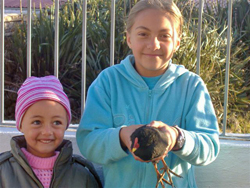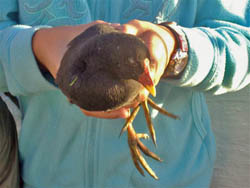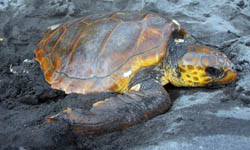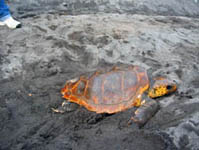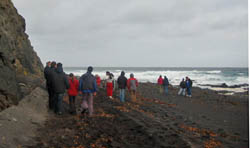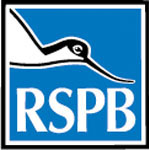 |
Killer Mice bring Albatross population closer to extinction See also the Albatross Page | |
The Tristan albatross, one of the world's most threatened birds, has suffered its worst nesting season ever, according to RSPB research. The number of chicks making it through to fledging has decreased rapidly and it is now five times lower than it should be because introduced predatory mice are eating the chicks alive on Gough island - the bird's only home and a South Atlantic territory of the United Kingdom. The mice are also affecting the Gough bunting – one of the world's largest finches – another species endemic to Gough Island . A recent survey of the bunting's population reveals that the population has halved within the last two decades. Now there are only an estimated 400-500 pairs left. Despite the grave situation for both species on Gough Island , government funding to plan for and take forward the eradication of mice is still lacking. This is despite recognition from two prominent House of Commons' Committees that the "biodiversity found in the UK Overseas Territories is equally valuable and at a greater risk of loss" (than the UK ) and that current levels of funding are "grossly inadequate". Eradicating mice is the single action that would solve the primary conservation threat facing both species. Because of the impact from introduced house mice, both the Tristan albatross and the Gough bunting were listed earlier this year as Critically Endangered, by BirdLife International. This is the highest level of threat before extinction. Richard Cuthbert is an RSPB scientist who has been researching the mice problem on Gough Island since 2000. Commenting on the latest results he said: "We've known for a long time that the mice were killing albatross chicks in huge numbers. However, we now know that the albatrosses have suffered their worst year on record. "The mice do not affect the adult albatrosses, but we know from our work that these are being killed by longline fishing vessels at sea. So, unsustainable numbers of this bird are being killed on land and at sea. Without conservation efforts, the Tristan albatross is doomed. We also know that the mice are predators on the eggs and chicks of the Gough bunting and mice predation is the main factor behind their recent decline. We also suspect that the mice may compete with the buntings for food, especially during cold winters." Collaborator Peter Ryan from the University of Cape Town 's Percy FitzPatrick Institute has been studying buntings at the island since the 1980s. He said "The decline in bunting numbers is alarming. Without urgent conservation action to remove the mice, both the albatross and the bunting are living on borrowed time." A complete survey of the Tristan albatross on Gough Island in January showed there were 1764 adult albatrosses incubating eggs. A later survey revealed that only 246 chicks had survived to fledging. Richard Cuthbert added: "While some breeding failures would have occurred naturally, the majority of these would have been killed by mice. Far higher numbers of winter-breeding burrowing petrels are also predated by mice. For example, we estimate that half a million Atlantic petrel chicks will have been eaten last winter." The RSPB has been involved in a feasibility study to test whether it's possible to remove the mice. So far, the trials look promising, giving both birds a more optimistic future. Funding on this year's work on Gough has come from the Overseas Territory Environment Programme (OTEP). Removing rats from seabird islands has been conducted in several parts of the world with great success, and the RSPB is working with New Zealand conservationists to tackle removal of the smaller mice. The procedure will involve dropping poisoned bait from helicopters. Alistair Gammell is the RSPB's International Director. He said: "We are grateful to the Government for funding to allow us to assess the feasibility of removing mice. "It is essential that the Government commits adequate funding for the protection of the many threatened species found on the UK 's Overseas Territories . Media release from RSPB on Thursday 11th December 2008 |
Gough and Inaccessible Islands declared RAMSAR sites The following announcement was made by DEFRA on 29th October 2008 : Huw Irranca-Davies, Minister for Wildlife said: "It is great to be able to add Gough Island and Inaccessible Island to the global list of wetlands of international importance. Some of the world's rarest species are found only on these islands, and designation of the islands and surrounding sea under the Ramsar Convention is recognition of their importance". Problems faced by the environment in overseas territories are similar to those faced by all our wildlife, including the threats of climate change and invasive non-native species. Many of the species on these islands face their own uniquely challenging conservation issues. The islands are already covered by Environmental Charters between the UK Government and the Governments of UK Overseas Territories, and this is a positive message to the international community of the importance of these islands. |
| ||||||||
| |||||||||||
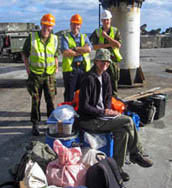 |
Lyme Bay conservation visit
Karen Varnham, a consultant on rodent eradication sponsored by the RSPB arrived on the RFA Lyme bay on 28th February 2008. While joining the ship in Cape Town Karen was able to provide valuable support and advice in ensuring the Lyme Bay left Cape Town free of invasive and alien species which might have been inadvertently landed here thus posed a threat to Tristan's native flora and fauna. Karen is here primarily to take forward work on plans to eradicate rodents from Tristan and Gough. This involves consultation and briefing of the community as well as an explanation of what the project will mean to the island. A full report on her visit will follow in due course.
Karen is pictured with Lt Commander Anthony Richards RN, Captain Paddy McAlpine RN and Troop Commander Tristan Wootten RE of Operation Zest. | |
Environmental education across territories The organiser of the project, Ann Pienkowski aims to raise awareness and promote environmental education through an on-line discussion forum. Working with students in the Crown Dependency of Jersey, a version of the online discussion forum is ready for piloting, and Ann hopes that Tristan islanders and interested Association members or website visitors will take part. Simply click on to www.ukotcfgroup.org/forums and have a go! you will then be a part of this new web-based project to learn more about and promote awareness of the rich and diverse environment of the Tristan da Cunha Islands and other UK overseas territories. |
John Cooper's Photographic Guide to 2007 Agulhas Trip Conservation Highlights |
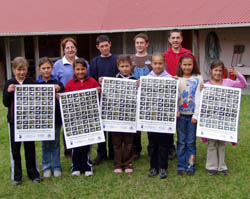 |
Some of St Mary's school children, with Anne Green, school teacher and former Chief Islander, proudly pose with their own copies of a Tristan Albatross poster, donated by the Agreement on the Conservation of Albatrosses and Petrels (ACAP), which Tristan ratified in April 2006. The Tristan Albatross is endemic to the Tristan Group, with nearly its whole population breeding on Gough Island. Photo: John Cooper. See below for large version of the poster. | |
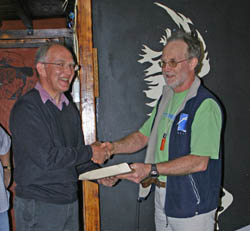 |
John Cooper, honorary Tristan Conservation Officer, presents a copy of a book on the natural history of Gough Island to outgoing Administrator, Mike Hentley, at the South African meteorological teams' takeover party on Gough in September 2007. The presentation was made to mark the many conservation initiatives that Mike Hentley has supported and seen through to completion during his period as Tristan's Administrator. Examples include the awarding of numerous OTEP (Overseas Territories Environment Programme) projects, ratification of the Albatross and Petrel Agreement (ACAP) and adoption of Tristan's new conservation ordinance. Photo: Andrea Angel. | |
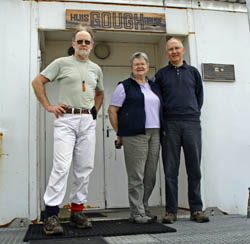 |
Left: The outgoing Tristan Administrator, Michael Hentley, with his wife Janice and John Cooper, honorary Tristan Conservation Officer, on the steps of Gough House next to the World Heritage plaque, September 2007. Photo: Andrea Angel. |
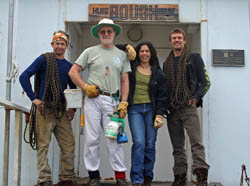 |
Right: The September 2007 Sagina eradication team on Gough after another successful campaign. From left, Eugene Breytenbach, John Cooper, Andrea Angel and Matthew Munting. Photo: Andrea Angel |
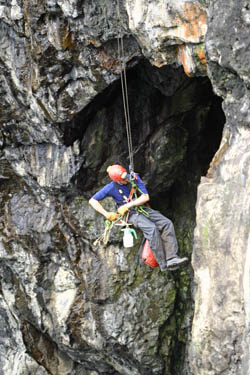 |
Left : |
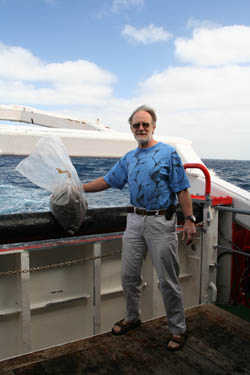 |
Right: Photo : Andrea Angel. |
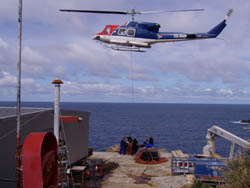 |
Left: Helicoptering boxed alien Sagina plants off Gough to the waiting SA Agulhas in September 2007. |
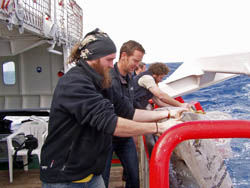 |
| Brother takes over as Tristan's Conservation Officer |
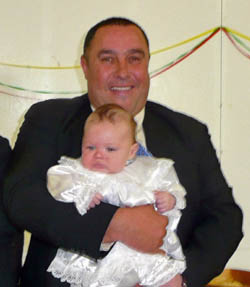 |
Trevor Glass has replaced his younger brother Simon as Tristan da Cunha's Conservation Officer. Trevor is photographed left with his young son Tristan on the occasion of his Christening on 1st July 2007. Trevor reports that his conservation job is going really well. He is involved in several assignments, and he highlights three on-going current projects : A particular concern is the control of loganberries at Sandy Point, which have grown throughout the apple and plum orchards and are extending up the cliffs towards the Base, which is lower in this part of the island and has many Atlantic Yellow-nosed Albatross nests. Trevor hopes to send tristandc.com photographs of this encroachment and work in progress to control it. A Northern Rockhopper Penguin count is being organised on Nightingale and Middle Islands, the latter not done since the 1970s. Trevor also plans a fur seal count on Tristan as their numbers are on the increase and a theory that they may be threatening rockhopper penguins will be tested. | |
Stunning New Tristan Albatross Poster Tristan Voluntary Conservation Officer John Cooper has sent tristandc.com a copy of a new A2 poster jointly published by (ACAP) Agreement on the Conservation of Albatrosses and Petrels and the (TANRD) Tristan Agricultural and Natural Resources Department, although the former footed the whole bill. Copies will be sent to Tristan with James Glass in August 2007 to give out to each school child with ACAP's compliments. |
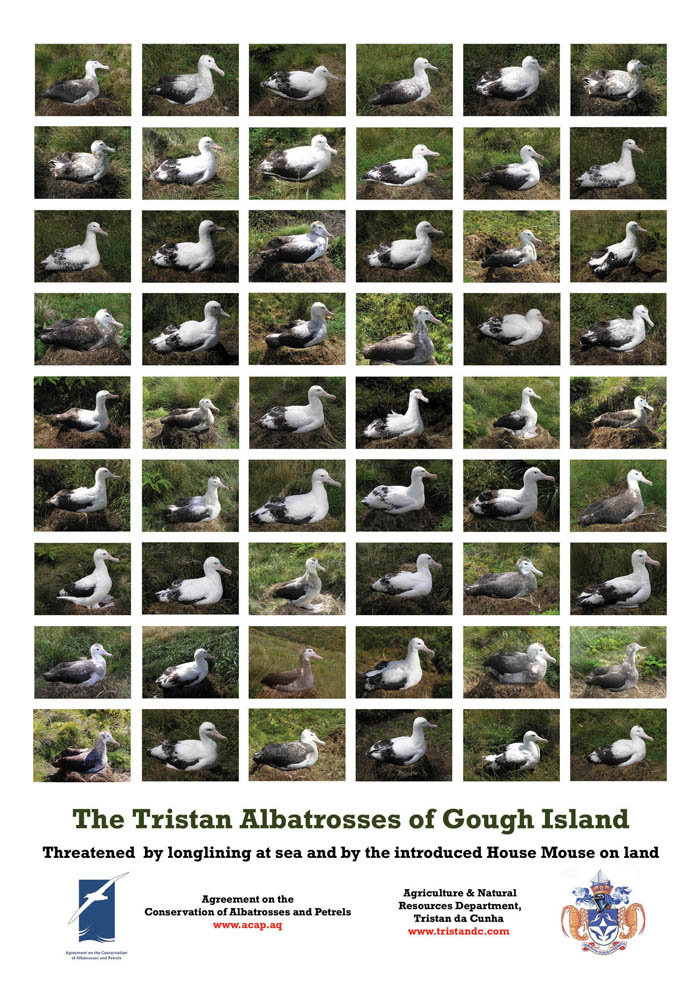 |
Invasive Species Capacity Building Project Underway Invasive species have been recognised as a threat to biological diversity worldwide, and the threat is particularly severe for island states. In order to build regional capacity to deal with this issue, the European Commission's DG-Development has funded the South Atlantic Invasive Species Project, in which the Government of Tristan da Cunha is a partner. The project has now been running for almost six months, and is being implemented by RSPB. Work is ongoing to assess the status of invasive species in Tristan, and to set priorities for project activities over the next two years. Clare Miller, the project manager, has been visiting Tristan in April and May 2007 to get this process underway, working with the Tristan Agriculture and Natural Resources Department. For more information on the project, please contact |
| £75,000 Marine Environmental Grant Announced Some more good news on the environmental front was received on 28th March 2007 as support from the UK Department of Environment's Darwin Initiative was announced. This will fund a marine bio diversity project, run in partnership with RSPB Global Programmes Officer Sarah Sanders, Marine Biologists Sue Scott and Cameron Hay, and Rob Anderson & John Bolton of the University of Cape Town. The funding of some £75,000 spread over the next two financial years will finance underwater survey dives, particularly around Nightingale & Inaccessible. The additional data collected will help Tristanians manage their economically important fisheries sector in a sustainable way. A local diving team will also be trained in environmental monitoring of the Trypot Bay area where the stranded oil rig was removed earlier this year. They will also be able to assist in planned work to refurbish and improve the ageing Calshot Harbour. Other benefits of the project will include more visual information on the colourful and atmospheric underwater life and scenery around the Islands. A planned issue of postage stamps featuring local marine invertebrates is also eagerly awaited by collectors. |
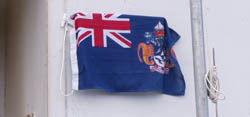 |
Ceremony to unveil World Heritage Plaque on Gough Island | |
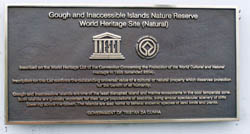 |
The new plaque situated at the entrance to the South African Weather Station on Gough Island. | |
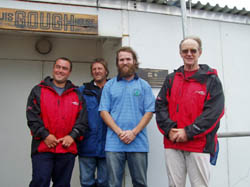 |
Right to left - John Cooper (Tristan Honorary Conservation Officer), Brian Bowie (Leader, Gough Base Team), James Glass (Head of Tristan's Agriculture & Natural Resources Department) and Simon Glass (Tristan Conservation Officer). | |
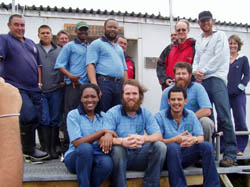 |
The 6 Gough Base Team members (blue shirts),John Cooper with Justin Fiske, Marienne de Villiers & Andre Fourie who form the sagina eradication team, (right) and visitors from Tristan Trevor Glass, Rodney Green, James Glass and Simon Glass. | |
| MV Edinburgh departed on 28th January 2007 en route for Cape Town via Gough Island to drop off Tristan Conservation Officer Simon Glass and his colleague Matthew Green who together with leader John Cooper, Justin Fiske, Marienne de Villiers & Andre Fourie form a team continuing to eradicate sagina grass and study the Gough colony of the Tristan Albatross. The teams were landed on Gough on the afternoon of Monday 29 January in good conditions. They are currently due to be collected on or around 12 March when the Edinburgh passes via Gough on it's scheduled trip to Tristan then. |
Thursday 9th February2006 Five hundred years after the discovery of the South Atlantic islands of Tristan Da Cunha, the unique wildlife of the UK Overseas Territory will receive greater protection, thanks to a new Conservation Ordinance. At a ceremony, on the 9th of February, celebrating the 500th anniversary of the islands' discovery, His Excellency the Governor of St Helena and Dependencies, Michael Clancy, presented the new ordinance to: Mr Mike Hentley, the islands' Administrator; Mrs Anne Green, the Chief Islander; and Mr James Glass, Head of the Tristan Natural Resources Department. |
|
Pull the other leg, its got snails on! |
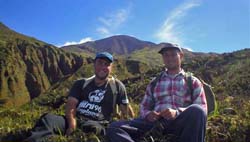 |
New Conservation Officer Simon Glass
Simon Glass was appointed Conservation Officer in the Natural Resources Department on the 20th September 2005. The purpose of his job is to conserve the bio diversity of the Tristan Islands through the Tristan Bio diversity Action Plan. His main duties are to develop and manage projects, and assist with existing monitoring programmes for seabird and seal habitats.
Simon will also develop monitoring programmes for other marine life and plants. He works with visiting scientists on projects where specific conservation problems have been identified, and help to develop research projects in conjunction with other organisations.The job also involves informing visitors about the wildlife of the Tristan Island group during wildlife tours around the islands. | |
| 2005 Photograph of Simon Glass with fieldworker Matthew Green on the Tristan mountain base with The Peak behind. |
|
OTEP-Funded Rat Eradication Feasibility Project holds successful workshop on Robben Island, South Africa |
25th July News Stories- 'super mice attack albatross chicks on Gough Island'
The shocking film, text and press photographs speak for themselves : large mice are a threat to seabirds on Gough Island. What we can confirm, is that the £220,000 grant announced on this website on 6th April, featured below, covers a feasibility study to eliminate mice on Gough and rats and mice on Tristan da Cunha. The Tristan da Cunha Government welcomes worldwide support in achieving these important objectives to secure the future for the unique range of sea birds on the two largest islands of the Tristan group. Readers may also like to know that Inaccessible and Nightingale Islands are free of rats and mice thanks to the strict adherence to conservation guidelines introduced for all visits to these islands by the Tristan community. The Tristan da Cunha Islands are a harsh environment, marginal for both wildlife and the unique human community who have survived and flourished on the main island despite formidable obstacles. Readers moved to want to help may like to join the Tristan Association today (see Membership Page) and receive the September Newsletter which is a bumper 16 page full-colour publication. |
| We publish below the full text of the RSPB Media Release on which all the TV and Press stories were based : |
Metre-high seabird chicks being eaten alive by mice - Millions killed on UK bird colony
Super size mice on a British Island are eating seabird chicks alive. The house mice, three times the size of those in the UK , attack at night and are devouring more than a million petrel, shearwater and albatross chicks on Gough Island every year. The island, a world heritage site in the South Atlantic , is the most important seabird colony in the world hosting more than ten million birds. It is one of the Tristan da Cunha group of islands – a UK Overseas Territory. Dr Geoff Hilton , a Senior Research Biologist at the RSPB said: “ Gough Island hosts an astonishing community of seabirds and this catastrophe could make many extinct within decades. We think there are about 700,000 mice, which have somehow learnt to eat chicks alive – much like blue tits learnt to peck milk bottle tops. “The albatross chicks weigh up to ten kilograms and ironically, albatrosses evolved to nest on Gough because it had no mammal predators – that is why they are so vulnerable. The mice weigh just 35 grams; it is like a tabby cat attacking a hippopotamus.” Gough Island is the most southerly of the Tristan da Cunha group. There are 22 bird species nesting on the island of which 20 are seabirds. The island hosts 99 per cent of the world’s Tristan albatross and Atlantic petrel populations – the birds most often attacked. Just 2,000 Tristan albatross pairs remain. The predatory behaviour of the mice was suspected then confirmed by Dr Richard Cuthbert , a RSPB researcher, and Ross Wanless, a PhD student from the University of Cape Town’s Percy FitzPatrick Institute. Ross Wanless recorded dramatic video footage of the attacks last year. “The albatross chicks spend eight months sitting waiting for food from their parents,” Dr Cuthbert said. “They are nearly a metre tall and 250 times the weight of the mice but are largely immobile and cannot defend themselves. Without predators this would not be a problem but for a carnivorous mouse population on one of the wettest and windiest places on earth it is an easy meal of almost unimaginable quality. The result is carnage.” Ross Wanless said: “There are mice on other South Atlantic islands but Gough is the only site where this is known to be happening. Once one mouse has attacked a chick, the blood seems to attract others. They gnaw into the chick’s body, create a gaping wound and the chick weakens then dies over several days.” Scientists suspect that the mice are also eating the eggs and chicks of the rare, ground-nesting Gough bunting, a small finch found no-where else in the world. Researchers think the finch has been forced from the best nesting sites into less suitable upland areas. “This species is one of the most worrying because there is no other population in the world,” Dr Hilton said. The Gough mouse is one of 2,900 non-native species damaging native wildlife on the 17 UK Overseas Territories and Crown Dependencies, a review by the Joint Nature Conservation Committee (JNCC) has found. Dr Vin Fleming , Head of International Unit at the JNCC said: “Non-native species are a major cause of the loss of bio diversity globally and their impacts are especially severe on island ecosystems typical of our Overseas Territories .” The RSPB has been awarded £62,000 by the UK government’s Overseas Territories Environment Programme to fund additional research on the Gough Island mice and a feasibility study of how best to deal with them. The grant will also pay for the assessment of a rat problem on Tristan Island , also a UK Overseas Territory, that unlike Gough has a human population and therefore pets and livestock as well. Media Release from the RSPB released 25th July 2005 |

